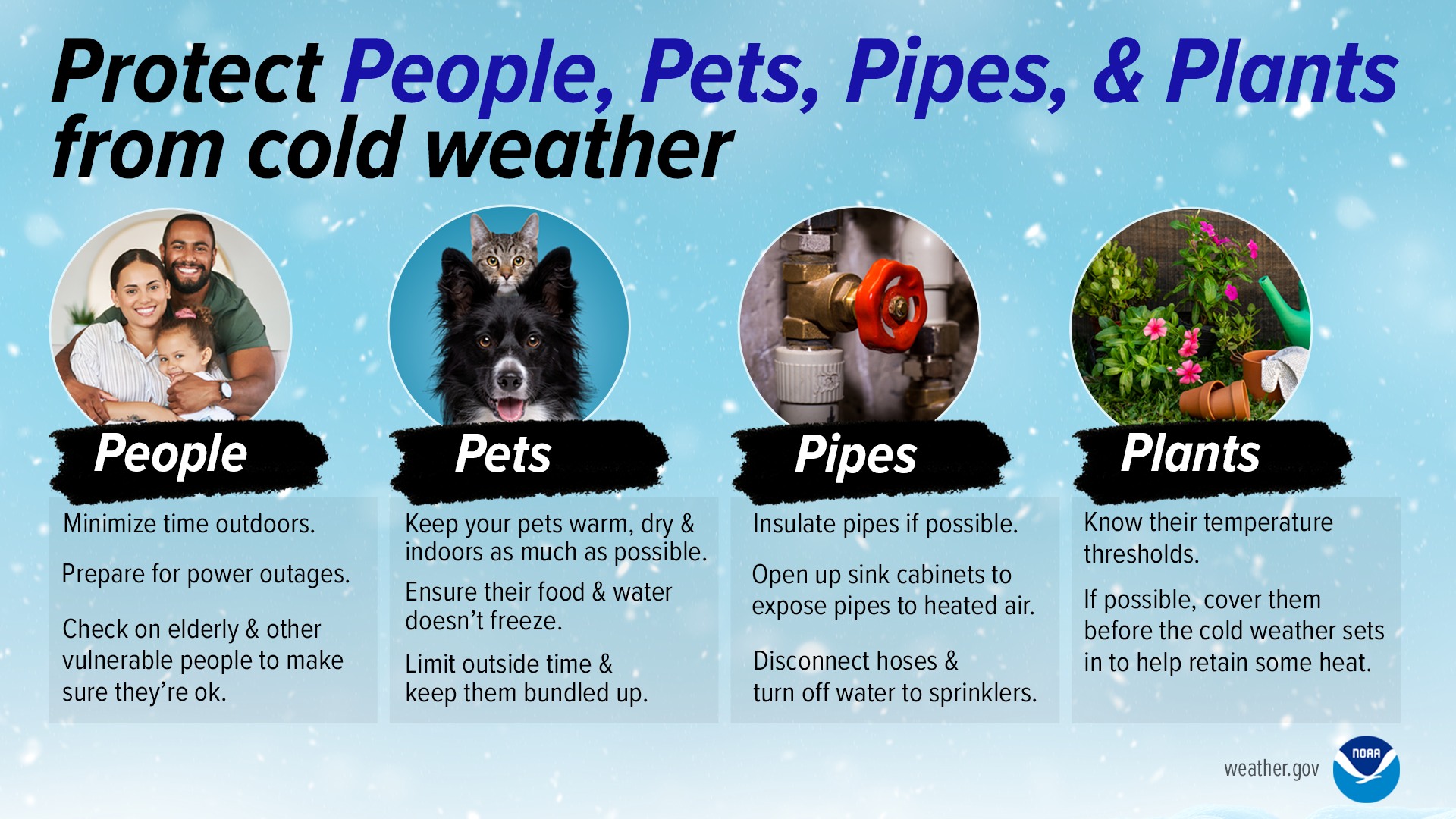The Texas Division of Emergency Management (TDEM) reminds the public to be prepared for this week’s freeze and to make a plan.
The ‘4Ps’ to remember are people, pets, pipes and plants.
Pipes
Click here to review tips from New Braunfels Utilities, Pedernales Electric Cooperative and The Texas Water Company on weatherizing your home, apartment, RV or mobile home.
People
Keep up to date with the forecast.
Stay warm, wear layers. The public is asked to check on neighbors who may be more vulnerable to the colder weather or may not have access to housing and heating, including the elderly and those with special needs.
TDEM’s winter storm safety tips include:
- Remain indoors if possible. If you must go out, dress accordingly, with layered, wind-resistant clothing, head covering—including your ears—and gloves or mittens to protect yourself against frostbite.
- If you must perform work outside, take frequent breaks to warm up, and avoid overexertion.
- Have emergency heating equipment approved for indoor use and appropriate fuel. Gas, kerosene, or propane heaters should not be used indoors because of the risk of carbon monoxide poisoning.
- In case of power loss, have emergency lighting, such as flashlights or lanterns, with a supply of batteries or fuel.
- Keep an emergency supply of ready-to-eat, non-perishable food, and an emergency supply of water on hand. Ensure you have a manual can opener available.
- Listen to your radio or TV for weather and emergency information. Have a battery-powered radio with spare batteries in case your electricity goes out.
- Travel only if absolutely necessary. If you must travel, do so in daylight. Have emergency supplies in your vehicle. Keep a blanket in your vehicle. Consider the use of snow tires or snow chains if appropriate.
The City of San Antonio Fire Department advises the public to:
- Keep anything that can burn at least three feet away from heating equipment, like the furnace, fireplace, wood stove, or portable space heater.
- Install and maintain CO (carbon monoxide) alarms to avoid the risk of CO poisoning.
- Never use your oven to heat your home.
- Never use a generator indoors.
- Always plug portable heaters directly into a wall socket (no power strips).
- Remember to unplug portable heaters when leaving the room or going to bed.
- Never leave children unattended in a room with a space heater.
- Test smoke alarms at least once a month.
Pets
With significantly colder temperatures expected, take steps now to protect your pets. The City of San Antonio advises:
- Bring pets inside. If you cannot have your pet inside the house, bring them in the garage, purchase an insulated doghouse, or build a protective enclosure that shields them from the elements and gives them a safe, warm place to rest.
- Shorthaired dogs, very young or old dogs, and all cats should not be left outside during winter months. Shorthaired dogs may benefit from a sweater while outside.
- Outdoor pets will need some extra food as it gets colder because they use up more energy trying to stay warm.
- Always provide fresh, clean water regardless of the season. Check water daily and clean bowls regularly to prevent algae growth.
- Antifreeze is deadly to pets. Store all chemicals out of reach, especially if you are going to bring your pets into the garage on cold nights.
- Before heading out to warm up the car, bang on the hood. A warm engine can be a welcome spot for a cold cat and the noise should scare them away.
State law says dogs cannot be tethered with any size chain at any time; it also states dogs cannot be left outdoors restrained and unattended in the case of officially defined extreme weather or situations in which an animal is in severe distress — including conditions in which the actual or effective outdoor temperature is below 32F.
Potential violators can face impoundment of their pet, fines up to $2,000 and 180 days in jail for repeat offenders.
Plants
To prepare trees for cold fronts and freezing weather, Texas A&M Forest Service suggests:
- Spreading mulch around trunks of trees for insulation.
- Wrapping trunks and bark of trees to prevent sun scalding
- Watering newly planted trees for soil moisture and insulation.
- Removing large branches posing a high risk.
To protect outdoor plants, water drought-stressed plants before a freeze to protect roots. Potted plants are more vulnerable because roots are above ground and should be moved inside.
Covering plants is the simplest, most practical way to protect against a frost or freeze, according to Texas A&M Agrilife Extension.
Use sheets, blankets, plastic, rowcovers or anything else to wrap up plants for a cold night.
Blankets do not keep a plant warm. The main source of heat for a plant is in the soil. On a cold night, heat from the soil rises up around the plants. Blankets can trap this heat within the plant’s canopy. Even cold soil is significantly warmer than freezing.
To cover plants effectively, lay the cover over the plant and allow it to drape down to the soil on all sides, then secure it with boards, bricks, and rocks or oil to hold in the air.
The next day, remove the covers to allow the sun to warm the soil surface and then replace covers as the sun goes down.
For more information, click here.




